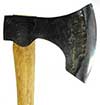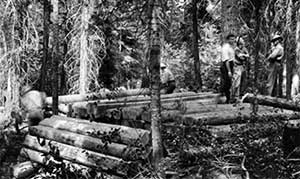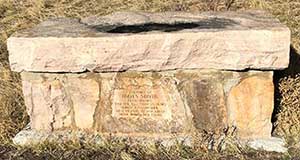Early Logging ~ Index
Some early experiences of logging in Logan Canyon, taken from the personal notes of Benjamin Wilmore of Logan.

From 1880 and for several years after I did considerable work in Logan Canyon chopping wood and getting out timber to earn a living. My brother George Wilmore, Thomas Greaves, Peter Nelson and myself, all boys of the Logan second ward, worked together. We cut timber and wood on the hills and in the hollows near and adjoining what was then known as the Temple Mill Canyon. Much dry timber had fallen and there was considerable green standing timber, all pine. We succeeded in cutting much timber and sliding it into the river and afterwards selling it to the United Order Lumber Mill. The timber was floated down Logan River to a boom at the mouth of the canyon.
We separated in pairs for work. A left handed chopper with right handed chopper can work well together felling trees. After the tree had fallen one could trim the limbs off while the other cut the tree in lengths, called logging it off. George Wilmore and Thomas Greaves paired and Peter Nelson and I paired. We worked in different places so as not to endanger or hinder either when sliding out timber down the mountain side to the river.
Many rocks and miniature snow slides made it very dangerous, especially should anyone be below the sliding timber. Sometimes a log with a good smooth snow surface to slide on, would go with terrific speed and very erratic as to the course depending on the hills, indentations of the mountain side. The timber would go downward with bullet speed and sometimes would strike a bump and fly through the air a long distance, with a successful landing on the mountainside or in the river below. Sometimes the timber was shattered into kindling wood.
At this time Charles O. Card, business manager of the Logan Temple construction, would make periodical trips to the Logan Temple Mill. We could see him pass in his buggy on such occasions. I remember Mr. Card as being a great fellow to ask questions, but with all that he was a pretty good chap.
Our camp was close to the river and on the canyon roadside, from the timber we had to make a footbridge to cross the river. In the early spring with the stream beginning to rise it was furious and made it difficult for wading. The only bridge was at the Temple Mill and this made quite a long distance from our camp. We found a tree close to the riverbank and felled it across the stream. The tree was about ten inches at the butt and maintained its size for a considerable length. We skillfully cut the tree so that it fell in the spot we desires. The practice of felling timber with experience becomes almost a perfection. We could fall our timber just about where we wanted to. Our footbridge in place the next thing to do was to trim off the limbs. Trimming a tree on the ground is quite different from trimming a tree across a roaring stream of water. Standing on a ten-inch log, swaying up and down with the swing of the ax needed some acrobatic practice. We could do very well near the riverbank hacking the limbs off but on the log in the middle of the stream we had to sit straddle of the log and trim it. The up and down sway of the log with the roaring water below was quite a sensation. It took more effort than one would think to accomplish such a seeming simple task. With good cheer and kidding each other, we accomplished what we set out to do and our bridge was completed. It was quite a task to walk across the log with confidence. At first we cooned over on our fours. We used our axes to cut into the log to steady ourselves. We soon became accustomed and could walk along the log without much fear of falling in. It was just another lesson that if you don't succeed as you expect, keep trying and you will in due time. Our experience swing an ax seven hours was a good stiff day's work. We quit work measured by our strength. We always landed in camp only a few minutes apart.
Near to our camp and across the river the ledges of rock rise like steps with very little room to stand and difficult to find footing. Pete and I decided to cut a tree that was on the ledge. The tree was leaning considerably downhill. We calculated the cut to pull the tree to make it fall on the side hill. We went to work and down it came, swinging around completely with the top of the tree directly up the hill with the butt of the tree hanging on the stump. Quickly, I jumped on the lower side of the stump as there was no time to jump to the side and out of the way. Quick as a flash the tree passed over the stump and me and I was unharmed. The tree went dashing down the steep mountainside into the river. It was my only chance and I did the right thing at the right time by jumping and crouching down behind the stump and let the tree pass over me with the stump for protection. Pete had got out of the way before and it was up to me to give the last stroke with the ax. Pete could see my predicament and he was pale and shouted, Look out!
I have always thought a lot of Pete for his fear and concern of my safety. I considered it a providential escape from death or a serious injury to me.
Spring being fairly well along we had to seek drifts of snow on the shady sides of the timber or ledges to get drinking water. We went up to a clump of trees where we had previously made a small water hole. We noticed some fresh bear tracks near the water hole. These were larger than we had ever seen before. We concluded a large grizzly bear was near us. We did not have a gun and were not looking for trouble so we left in a hurry and got our water from another place. We told our partners about our bravery. We were satisfied to let it go that way however.
Working down the mountainside from the Temple Saw Mill Canyon, Pete and I decided to work in the last steep hollow where high cliffs of rock face the sunshine. The timber was on the lower or shady side of the mountainside. Before crossing the hollow to reach some timber on the shady side of the mountain, I was strongly impressed not to cut any timber in or near the hollow, but cut farther away. We went along the steep mountainside. I grasped a limb of a large fallen tree that was resting on a ledge or rock. My weight caused the tree to over balance. I called to Peter to get on the upper side and hold the tree which he did quickly. I worked my way around and got out of danger. I then said, Let her go,
to Pete and the tree rolled to the bottom with a great crash. If I had been under it I would have been flattened to pulp, so my life was spared again.
We then started to fall a tall stately pine. After the first few strokes of our axes a terrible crash, like the roar of a cannon, was heard at the head of the canyon hollow where I had been impressed not to go. We were startled and a great mass of rock and earth came down the hollow. It was a rock and landslide. Large rocks went in great leaps here and there on the way down and jumped across the hollow into a grove of pines where we had planed to cut. After the slide had passed we crossed the hollow and finished our days cutting. We were very thankful we had followed the impression and our lives spared again. I shall always remember my logging days in Logan Canyon.
Logging for Railroad Ties
Supplementing what Mr. Benjamin Willmore of Logan had to say about logging in early days in Logan Canyon, Mr. John Johnson of Millville, one of the original pioneers of Hyrum; and the journal of James A. Hovey, (deceased) one of the original pioneers of Millville, have the following to add about the early logging days in Blacksmith Fork Canyon.
In the year 1877 Coe and Carter had a contract to furnish railroad ties for the Union Pacific Railroad Company. A large number of ties were cut in Blacksmith Fork Canyon and East Canyon, east of Avon. Coe and Carter paid thirty, thirty-five, and forty cents each for ties cut in eight foot lengths, hewed on both sides and piled on the river bank. This induced quite a number of timber-men from Hyrum, Millville, Paradise and other settlements in the south end of the valley to cut ties in these canyons.

Coe and Carter established their headquarters or commissary just below the present Peterson (Hardware) Ranch in Blacksmith Fork Canyon. Practically the whole south slope of the Blacksmith Fork Canyon on the south side of the river was covered with timber in different sizes. This included the large Dry Hollow. Only red pine was cut for ties for this company. Trees ranging from six to eight inches in diameter were cut by the private cutters. This made from two to three ties in each pine tree. After the tree was cut, it was trimmed, cut into eight-foot lengths and hewed where it fell. Some used a broad ax and became expert hewers. They made very even and smooth ties. With a little snow and a steep mountainside, it was an easy matter to slide the ties down to the riverbank. Coe and Carter's men would come along and mark the ties. If the ties were marked with a "C" they were accepted. If marked with an "X" they were rejected.
When the river was high in the spring, Coe and Carter's men went along and floated the ties down the stream. The ties floated from the Blacksmith Fork River into the Logan River, from the Logan River to the Muddy, (Little Bear River) from the Muddy into Bear River. In the Bear River the ties were floated on to Corinne, an important railroad junction in Box Elder County a little north west and about seven miles from Brigham City. Here the ties were snaked out of the Bear River and loaded onto railroad cars to be used for railroad building. Considerable timber and ties were cut up East Canyon, east of Avon and floated down the Little Bear River into the Muddy River and then into the big Bear River.

Quite a bit of timber and ties were cut in the big Dry Hollow in the Blacksmith Fork. In this hollow in the early seventies, some men from Hyrum had a small mining prospect. They had a little shack on the side of the hollow. In the spring a terrific snow slide came and buried the men and shack under fifteen feet of snow. The alarm was given in Hyrum and a number of men rushed to Dry Hollow and began to dig the men out. They dug down to the shack, which was crushed in. Two of the men were found dead, they were Alva Benson and June Bradley. Lewis Halverson was one of the miners but was not trapped with the slide.
Coe and Carter installed a saw in Hayes Canyon south east of the Peterson (Hardware) Ranch. There was much timber, red and white pine, in this narrow canyon. Considerable team and handwork were provided hauling lumber from this saw mill to Hyrum. Several camps to cut railroad ties for Coe and Carter were established in Dry Gulch.
Snowslides
The following experience in Dry Gulch in Blacksmith Fork Canyon is taken from the Journal of James A. Hovey:
I spent the winter of 1877 with other men in Blacksmith Fork Canyon getting out railroad ties for Coe and Carter. Coe and Carter had a contract with the Union Pacific Railroad Company to furnish railroad ties. They had a camp or headquarters just below where the present Peterson (Hardware) Ranch is.
In February of that winter a big thaw came and a snow slide which nearly buried our camp. We had a shack built in the side of the slope of Dry Gulch, about seven miles east of the Curtis Ranch, later, the Hardware Ranch. We did not go out to work that particular morning the slide came as it was snowing considerably. We were playing cards and said when we dealt one more hand around and played it, we would go. Just as we got the cards dealt the snow slide came. It seemed the whole mountain was moving down upon us with an awful roar and then a great rush of wind and snow. The wind from the snow slide blew all our cards off the table and up the old chimney, up on the side hill. We heard a man scream, that a man and horse were buried. We scrambled out and heard the man yell. We dug him out with our shovels.

A little lower down the gulch the slide had struck another shack more squarely and the shack had caved in and killed a man. The shack had heavy saplings laid across it for a roof and when these fell on this particular man he was crushed to death. There was considerable excitement. It was a wonder more were not killed, as there was a group in this shack playing cards. The body was taken to the headquarters and buried near by. The grave may be seen to this day just west of the present Peterson Ranch near the roadside. The man was from Kansas. Some of his friends who were also from Kansas left immediately as they had had enough of the mountains and snow slides. They said they would rather have Cyclones than snow slides. They were plainsmen and not used to the mountains.
We boys struck out for the Curtis Ranch, (Hardware Ranch) about seven miles down the canyon. After dinner we started to walk for our homes, about twenty-five miles away. It was 4:00 p.m. For the night we stopped at an old sawmill about fifteen miles down the canyon. While going down the canyon we crossed nine snow slides. We arrived home at 9:00 a.m. for breakfast. We never went back for any of our outfit as we knew it would soon be taken.
After most of the timber in Blacksmith Fork Canyon was cut, that was suitable for railroad ties, for years the canyon furnished firewood and some lumber, including house logs, for the people.
Notes by the Compiler

The canyons and streams were very important resources for the early settler in Cache Valley. Much timber was cut for ties in Logan and Blacksmith Fork Canyons for the railroad. Also much timber was cut and used for most of the buildings in all the settlements, including the Logan Temple and Tabernacle. The timber was used for years for firewood until the railroad bought coal here. Much rock was quarried in Logan, Green and Blacksmith Fork Canyons and other places in the valley for building purposes, including the building of the Logan Tabernacle and Logan Temple. For years all the lime used for the building trades and otherwise was obtained from lime rock in Logan and Green Canyons. Since the establishment of the sugar factories in Cache Valley, most of the lime was taken from the deposit in Providence Canyon. There has been considerable prospecting for minerals in the mountains of Cache Valley but without much success.
The streams furnished waterpower and water for irrigation, all so vital to the people and development of Cache Valley. Fish and game in the streams have always been an important asset. The canyons have been very useful and valuable for the grazing of livestock, principally sheep and cattle. The recreation value of the canyons lakes in Cache Valley cannot be measured in money. Logan Canyon is considered one of the most beautiful and remarkable canyons in the country.